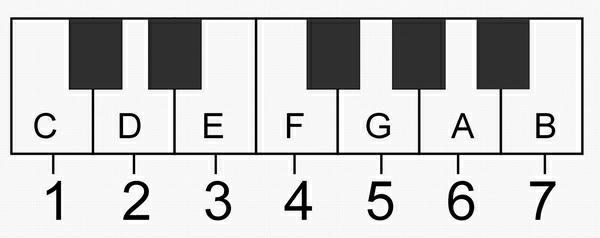Translator for translating chord mark with other melodies in numbered musical notation into C melody chord mark
A technology of translating into and translating, which is applied in the field of translators, which can solve problems such as inability to change chord marks, and achieve the effects of simplifying memory, convenient use, and convenient performance
- Summary
- Abstract
- Description
- Claims
- Application Information
AI Technical Summary
Problems solved by technology
Method used
Image
Examples
Embodiment 1
[0035] Embodiment one: Refer to attached Figure 7 , 10 , 12, 13, the musical score involved in the present invention refers to notation with digital numbered musical notation. The key in the present invention refers to the position of the "1" sound; the chord mark in the present invention is marked by the fixed chord notation method adopted. The sound sequence mentioned in the present invention refers to a list in which sound names are arranged in a certain order. This translator that translates the chord marks of other keys in the numbered notation into C key chord marks includes a base card 14 and a transposition card 22, and the base card 14 is respectively provided with a sharp tone number 13 and a sharp tuning column 15, the described ascending kind of tuning column 15 is the sound name C, # C, D, # D, E, # E. # F, G, # G, A, # A, B, C, # C, D, # D, E, # E. # F, G, # G, A, # A and B are arranged, such as Figure 7 shown. Generally, the commonly used asc...
Embodiment 2
[0036] Embodiment two: Refer to attached Figure 8 , 10 . b D, D, b E, E, F, b G, G, b A, A, b B. b C, C, b D, D, b E, E, F, b G, G, b A, A, b B. b C is arranged as Figure 8 shown. Generally, the commonly used descending tone is 1= b D. b E, F, b G. b A. b B, the arrangement of the commonly used descending tone number 17 is arranged in the order of the note names of the commonly used descending tone appearing for the first time from left to right in the above-mentioned descending tone column 18. The described descending tone number 17 corresponds to the same tone name position that appears for the first time in the described descending tone column 18, when the descending tone number 17 appears for the second time in the descending tone column 18 Then it is not necessary to mark above the descending tuning column 18, and the descending tuning number 17 is arranged on the side corresponding to the descending tuning column 18. Other structures are the same ...
Embodiment 3
[0037] Embodiment three: Refer to attached Figure 9 , 11 . The ascending tone number 13 and the descending tone number 17 are respectively arranged on both sides of the base card 14, and the ascending tone column 15 and the descending tone column 18 are arranged in the middle of the base card 14, wherein the ascending tone The number 13 is arranged on the upper side of the ascending tuning column 5, and the descending tuning number 17 is arranged on the lower side of the descending tuning column 18. Likewise, the arrangement order and setting positions of the ascending tone number 13 and the falling tone number 17 are the same as those in the first and second embodiments; after the base card 14 is changed, the transposer card 22 will of course be changed accordingly. That is, on the transposer card 22, the hollow display holes 21, 21' have two rows, and the pointers 19, 19' are set on the transposer card 22 corresponding to the first sound level "1" of the C major scale 2...
PUM
 Login to View More
Login to View More Abstract
Description
Claims
Application Information
 Login to View More
Login to View More - R&D
- Intellectual Property
- Life Sciences
- Materials
- Tech Scout
- Unparalleled Data Quality
- Higher Quality Content
- 60% Fewer Hallucinations
Browse by: Latest US Patents, China's latest patents, Technical Efficacy Thesaurus, Application Domain, Technology Topic, Popular Technical Reports.
© 2025 PatSnap. All rights reserved.Legal|Privacy policy|Modern Slavery Act Transparency Statement|Sitemap|About US| Contact US: help@patsnap.com



